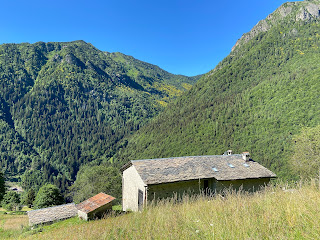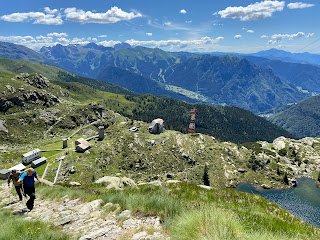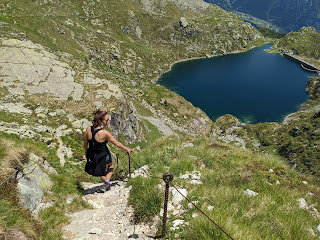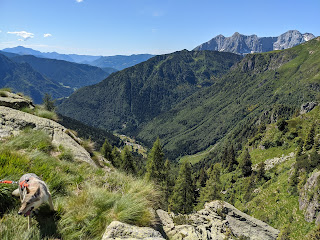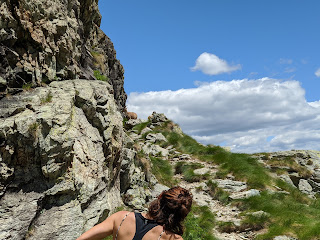Top Left: Overlooking Lago Sucotto. Upper Left: Lago Nero above Vagoglio, Italy.
Bottom Left: Cinque Laghi trail stats and profile. Bottom Center: Center of Valgoglio. Center Right: A patch of snow left above Lago Nero on the way to Lago di Aviasco.
Overview
Length: 12.4 km (7.7 mi)
Duration: 6.0 hours total, with 45-minute lunch break at north end of Lago Nero
Elevation: 1,177 m (3,862 ft) @ start/end of hike at Parcheggio Località Becc; max elevation 2,081 m (6,827 ft) between Lago di Aviasco and Lago Campelli Alto; elevation gain 1,321 m (4,334 ft) reported by viewranger
Location: Italy, Lombardy, Bergamo, Alta Val Seriana, Valgoglio
Duration: 6.0 hours total, with 45-minute lunch break at north end of Lago Nero
Elevation: 1,177 m (3,862 ft) @ start/end of hike at Parcheggio Località Becc; max elevation 2,081 m (6,827 ft) between Lago di Aviasco and Lago Campelli Alto; elevation gain 1,321 m (4,334 ft) reported by viewranger
Location: Italy, Lombardy, Bergamo, Alta Val Seriana, Valgoglio
Details
The post A Short Hike to Cinque Laghi, Above Valgoglio documents our first experience just about two years ago today. Back then, the day was grey and cool, and we were part of slower moving group, so we did not do a tour of the lakes. This time, the weather was perfect, and we did make it around to visit all five of the principal lakes.
Hiking up to the lake and visiting the five principle lakes will involve these trails: CAI 228, CAI 229, CAI 268. The trail is very well signed and worn, so you will not get lost. The biggest choice you have is whether to do the tour of the lakes clockwise or counterclockwise. We chose the former. There were a few parts of the trail – heading to Sucotto – where the trail was steep and had cables for grips (visible in one of the photos in this post).
You will notice in photos of this post that we are hiking with masks, which are still required here in Lombardy – on the date of this hike. We usually wore them under our chins or took them off when not near other hikers, but put them back on when approaching others within six or so feet. There you go, hiking during the coronavirus pandemic.
Very visible along the trail is the green condotta forzata (pipeline) that carries water from the lakes down to the Centrale di Aviasco (station) at 984 m, for a drop of about 1,000 m. The Aviasco station can supply the energy needs of about 10,000 families. The station was built in 1925, and the Lago Nero dam was constructed in the 1920s by Azienda Elettrica Crespi, placing the dam projects somewhere in the early 1920s. What’s interesting is that these dams seem to be connected to Crespi d’Adda. The Crespi family was behind hydroelectric projects on the Adda river, like the Taccani Hydroelectrical Power Station. We couldn’t find any easy resource talking about what Crespi was doing in the mountains of the upper Val Seriana.
Going clockwise from the “ENEL Village”, you will arrive at the five principle lakes:
- Lago Nero (2,014 m) – artificial
- Lago di Aviasco (2,070 m) – artificial
- Lago Campelli Alta (2,037 m) – artificial
- Lago Cernello (1,958 m) – natural
- Lago Sucotto (1,854 m) – natural
After the grind of the first part of the trail, you end up on a sort of plateau called Villaggio Enel. As with all names, we wonder, why was it named like that?
Names: It pains us to no end not to know about all the lake names on this hike. Lago di Aviasco is called that after the nearby pass of the same name. Lago Nero is named so because of its dark waters or so we read. However, the origin of the names of Cernello, Campelli and Sucotto eluded us.
So, what is ENEL? Enel S.p.A., or the Enel Group, is an Italian multinational energy company that is active in the sectors of electricity generation and distribution. ENEL is an acronym that stands for National Entity for Electricity (Ente Nazionale per l’energia Elettrica). It was formed in 1962 when Italy nationalized the production and distribution of electric power. ENEL, we are guessing took over the hydroelectric production of these lakes, modernized, and created this villaggio as a place for workers to stay.
Flora
Today, one of the plants we noted latest time Daphne striata, was again in abundance, and this time got down on our knees to breath in the wonderful scent it produces.
We saw many of the same plants as we did last time – being the same time of year – only with with better lighting.
As usual, check out our flora resources page Resources for Identifying Plants around Bergamo and our Pinterest page.
Key: [Family] Genus species – Common name in English (Common name in Italian)
[Asteraceae] Cirsium sp.
[Boraginaceae] Myosotis – Forget Me Not (Nontiscordardimè)
[Campanulaceae] Phyteuma sp. – Globe Headed Rampion (Raponzolo alpino)
- A Phyteuma definitely, but which one is a kind of hard to know. P. hemispheericum is more common and is found at slightly lower elevations. For these reasons, we went with P. hemisphaericum.
[Ericaceae] Rhododendron ferrugineum – Alpenrose (Rododendro rosso)
[Fabaceae] Cytisus scoparius – Scotch Broom (Ginestra dei carbonai)
[Gentinanaceae] Gentiana clusii – Trumpet Gentian (Genziana di Clusius) - not pictured here
[Lamiaceae] Ajuga pyramidalis – Pyramidal Bugle (Iva piramidale)
[Lentibulariaceae] Pinguicula vulgaris – Common Butterwort (Erba unta comune)
[Liliaceae] Paradisea liliastrum – St Bruno’s Lily (Giglio di monte)
[Orchidaceae] Dactylorhiza maculata – Spotted Heath Orchid (Orchide macchiata)
[Papaveraceae] Corydalis lutea – Rock Fumewort, Yellow Corydalis (Colombina gialla)
[Plantaginaceae] Linaria alpina – Alpine Toadflax (Linajola alpina)
[Polygalaceae] Polygala chamaebuxus – Shrubby Milkwort (Poligala falso bosso)
[Ranunculaceae] Anemone narcissiflora – Narcissus Anemone (Anemone a fiore di narciso)
[Rosaceae] Potentilla reptans – Creeping Cinquefoil (Cinquefoglia comune)
[Primulaceae] Primula daonensis – (Primula della Valle di Daone)
[Primulaceae] Soldanella alpina – Alpine Snowbell (Soldanella comune)
[Scrophulariaceae] Verbascum alpinum – Mullein (Verbasco alpino)
[Thymelaeaceae] Daphne striata – Striped Daphne (Dafne striata)
[Violaceae] Viola biflora – Yellow Violet (Viola con due fiori)
References
Some references consulted in preparing this post.
- [Italian] Guide to the Villages of the Alta Val Seriana
- [Italian] All about river ecology
- Understanding the orgins of “goi” or “goglio” we needed to figure out what a buca fluviale molto profondo means. We think it can best be translated into pool using this resource.
- [Italian] Prima Bergamo article on the hike
- [Italian] Books we would love to consult about Cinque Laghi - but are super-specialized and hard to find
- [Italian] ProgettoDighe.it - where dam geeks go to talk
- [English] Pipeline transport - type seen on this hike
- [English] Energy Issues and Policies in Italy.
Left: [Asteraceae] Cirsium sp. Center: [Campanulaceae] Phyteuma sp. Left: [Lamiaceae] Ajuga pyramidalis – Pyramidal Bugle (Iva piramidale).
Left: [Boraginaceae] Myosotis – Forget Me Not (Nontiscordardimè). Right: [Lentibulariaceae] Pinguicula vulgaris – Common Butterwort (Erba unta comune).
Left: [Liliaceae] Paradisea liliastrum – St Bruno’s Lily (Giglio di monte). Center: [Ranunculaceae] Anemone narcissiflora – Narcissus Anemone (Anemone a fiore di narciso). Right: [Ericaceae] Rhododendron ferrugineum – Alpenrose (Rododendro rosso).
Left: [Fabaceae] Cytisus scoparius – Scotch Broom (Ginestra dei carbonai). Center: [Papaveraceae] Corydalis lutea – Rock Fumewort, Yellow Corydalis (Colombina gialla). Right: [Rosaceae] Potentilla reptans – Creeping Cinquefoil (Cinquefoglia comune).
Left: [Orchidaceae] Dactylorhiza maculata – Spotted Heath Orchid (Orchide macchiata). Center: [Plantaginaceae] Linaria alpina – Alpine Toadflax (Linajola alpina). Right: [Primulaceae] Soldanella alpina – Alpine Snowbell (Soldanella comune).
Left and Center: [Primulaceae] Primula daonensis – (Primula della Valle di Daone). Right: [Thymelaeaceae] Daphne striata – Striped Daphne (Dafne striata).
Left: [Polygalaceae] Polygala chamaebuxus – Shrubby Milkwort (Poligala falso bosso). Center: [Scrophulariaceae] Verbascum alpinum – Mullein (Verbasco alpino). Right: [Violaceae] Viola biflora – Yellow Violet (Viola con due fiori).
Left: At the beginning of the trial and a view of Val Sanguigno with the yellow of Laburnum visible. Right: The trail above Villaggio ENEL.
Left and right: A patch snow on the trial between Lago Nero and Lago di Aviasco.
Left: From the trail, a view of Lago Cernello. Right: The dam on Lago Cernello.
Left: The dam at Lago di Aviasco with trail indicators. Right: Walking around the north end of Lago Nero.
Left: The dam at Lago Sucotto. Right: View from the trail looking south down the Alta Val Seriana.
Left: Lago di Aviasco with Passo Aviasco in the distance. Right: Peek-a-boo with a camoscio - Rupicapra rupicapra.
Left: Sign describing the Parco delle Orobie Bergamasche. Right: Sign describing the Valle del Goglio River.



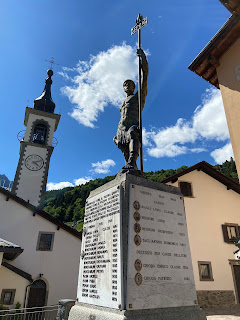

![[Asteraceae] Cirsium sp. [Asteraceae] Cirsium sp.](https://blogger.googleusercontent.com/img/b/R29vZ2xl/AVvXsEhc7PX7JeSmLN81zGme0SQMqmfakzqJaZnrYLUXm4feQ7ybK46_u_i1ctLA4L5jrTUUYztkz0yi9WJ9SdsKKErxJZei074mWO9cgSaiknM2DJtBsLyZZtS06kMX4dvq3fv64Ecw2xLlPas/s320/%255BAsteraceae%255D+Cirsium.jpg)
![[Campanulaceae] Phyteuma sp. [Campanulaceae] Phyteuma sp.](https://blogger.googleusercontent.com/img/b/R29vZ2xl/AVvXsEhYfebZLFhQUG9gxfLAezdWhzZRbuFFZFWB1FwnsazVhr72bfvWXW8VgjIwm8r3Us79mlDu4iPPUDChwbHYQkSzKJ9oHpUKZZfqrHfhdXdNZlKHltjq3p96-N9ips4L4ziUEceDSy8uTJE/s320/%255BCampanulacease%255D+Phyteuma.jpg)
![[Lamiaceae] Ajuga pyramidalis – Pyramidal Bugle (Iva piramidale). [Lamiaceae] Ajuga pyramidalis – Pyramidal Bugle (Iva piramidale).](https://blogger.googleusercontent.com/img/b/R29vZ2xl/AVvXsEjGoGc0JtmKiRO94grv7r-yhaiRMaedPESv4CZERrhOD8TfhMkMLqnZISroCzqU-0WcVFvobHpQI2y8hn999WgtGTCsl0Ex8W1swg5TiQHb4bCfZ3x3r88n8yCpUG0PghleVGs4orw_rng/s320/%255BLamiaceae%255D+Ajuga+pyramidalis.jpg)
![[Boraginaceae] Myosotis – Forget Me Not (Nontiscordardimè). [Boraginaceae] Myosotis – Forget Me Not (Nontiscordardimè).](https://blogger.googleusercontent.com/img/b/R29vZ2xl/AVvXsEhrikkkruIzIjgx4sNinnirfp5rfVINcYVFijc0F_YHlNI0MIUW4Pd8_Ogl5-extp3nsdlyWEFB1uDcOdicLoxgnLkC_LJ2SQ-s3hqKpz6piaCaBYvFN4alrku5KZOoSw5-j_1FJwIRtQ4/s320/%255BBorginaceae%255D+Myosotis.jpg)
![[Lentibulariaceae] Pinguicula vulgaris – Common Butterwort (Erba unta comune). [Lentibulariaceae] Pinguicula vulgaris – Common Butterwort (Erba unta comune).](https://blogger.googleusercontent.com/img/b/R29vZ2xl/AVvXsEjdoQrnIxVpG4tII61C3ETuJeJbB4b0LA1j74BJXKtjGcTeLLWBwLPEhVtdOJ_nXGa-1MI463nnFNrINBIZ5qBzpPFr-GRRXMW8Bf8gLwN9S5UryIkC2hZqZ6E-syO8qDGaAeDicERf7Q0/s320/%255BLentibularaceae%255D+Pinguicula+vulgaris.jpg)
![[Liliaceae] Paradisea liliastrum – St Bruno’s Lily (Giglio di monte). [Liliaceae] Paradisea liliastrum – St Bruno’s Lily (Giglio di monte).](https://blogger.googleusercontent.com/img/b/R29vZ2xl/AVvXsEhyQQ_OGVcXki5b5525UTz71UBV8IwRA-nSb0fNSsn1d9oUkCCYe-vRKq0I27ZKYyQCNimWHlgwXCN_IRCIBNI_hOsGExf5L9hYB80kjCmVlg6w47K6te2Ob_P1IuvfrGqnSyvgWTjbJlg/s320/%255BAsparagaceae%255D+Paradisea+liliastrum.jpg)
![[Ranuculaceae] Anemone narcissiflora – Narcissus Anemone (Anemone a fiore di narciso). [Ranuculaceae] Anemone narcissiflora – Narcissus Anemone (Anemone a fiore di narciso).](https://blogger.googleusercontent.com/img/b/R29vZ2xl/AVvXsEjxDD30xnCDEz9NMlhxB43O7jCvHhRYAF97m8gOwIoz-fjvs0PIbId4E_b5-Nr5o7ychk54sbWeneOqqnAPz5MXjUO9ZySnSEQegmbt7nJq9qppHAvj8EhDWA2_EhN-uwaUL9DDKpHA6fI/s320/%255BRanuculaceae%255D+Anemone+narcissiflora.jpg)
![[Ericaceae] Rhododendron ferrugineum – Alpenrose (Rododendro rosso). [Ericaceae] Rhododendron ferrugineum – Alpenrose (Rododendro rosso).](https://blogger.googleusercontent.com/img/b/R29vZ2xl/AVvXsEgtVDofTYggcNEeNml4O4kI5Fc0WlgJeY6FLS429HcjfdT1syS9MFnk7Clnl5ahLRxPf1MyU_WtZycSo-s6V4Yd_5mh47adQ0VniByyTE0z25-_LFQYaSKE43iiiEbki-HgU7yQAy31qw4/s320/%255BEricaceae%255D+Rhododendron+ferrugineum.jpg)
![[Fabacease] Cytisus scoparius – Scotch Broom (Ginestra dei carbonai). [Fabacease] Cytisus scoparius – Scotch Broom (Ginestra dei carbonai).](https://blogger.googleusercontent.com/img/b/R29vZ2xl/AVvXsEjXonrKLZ2k8p3AJRrGS97lNwkyV0tguH-1ugDi2vJGRygprnp7sUQWetkDZnEvdSi-O9wrxbzWMMMFNmYGN5tzCD6nrTISWj8k6sjW6NysLpWsQI4rMBuZsA_LnytvSiScP1elybqEm2E/s320/%255BFabaceae%255D+Cytisus+scoparius.jpg)
![[Papaveraceae] Corydalis lutea – Rock Fumewort, Yellow Corydalis (Colombina gialla). [Papaveraceae] Corydalis lutea – Rock Fumewort, Yellow Corydalis (Colombina gialla).](https://blogger.googleusercontent.com/img/b/R29vZ2xl/AVvXsEi7RwOj5xge7zWyUvEQZw_vW4gkWwGZTKtwlFb55kh0cY4wt8EEKEn3oBQOUaGFmrU43-1KwVlzePNr9ps7PBZVCro9p9m5YRjdWqjxn4UGK16hAGDX9XtlIWiCxYpwQcBOaJITcnanAPc/s320/%255BPapaveraceae%255D+Corydalis+lutea.jpg)
![[Rosaceae] Potentilla reptans – Creeping Cinquefoil (Cinquefoglia comune). [Rosaceae] Potentilla reptans – Creeping Cinquefoil (Cinquefoglia comune).](https://blogger.googleusercontent.com/img/b/R29vZ2xl/AVvXsEi4T8dx2pVeJlr1Yl0uKUfDsfx1s6a-YS9BRd_i5mpWCq4utWud4tSvDT58Nc0JjX4XmR3AXuFmHDgYkuXFLKNqecF3R8GGcMW1LiyAbEtt3pKggavVUBojpMf0tNb80LJtXBdMNDgCh6Y/s320/%255BRosaceae%255D+Potentilla+reptans.jpg)
![[Orchidaceae] Dactylorhiza maculata – Spotted Heath Orchid (Orchide macchiata). [Orchidaceae] Dactylorhiza maculata – Spotted Heath Orchid (Orchide macchiata).](https://blogger.googleusercontent.com/img/b/R29vZ2xl/AVvXsEjjnNd0glgtBsirj0rrTc1cal3cgm0e690XbjlJi9AXFJS5J2Vi_-LTYahsaPZpsjwdIaDv012IzDjtOxiGUTkE9UGUOOJnwUjPaLW91_RoMS_jdD2qbHDTMlfSNFByEzUA_VN-uKJqxjM/s320/%255BOrchidaceae%255D+Dactylorhiza+maculata.jpg)
![[Plantaginaceae] Linaria alpina – Alpine Toadflax (Linajola alpina). [Plantaginaceae] Linaria alpina – Alpine Toadflax (Linajola alpina).](https://blogger.googleusercontent.com/img/b/R29vZ2xl/AVvXsEixb9s6v1S8B8O1tRjdRAAc1mfOTKH3k9A2aiFCoXv3zPFSemULiS6xu4nHxdGhWpm_Vhxooc-eMfQvIAvZQb3jWmQIHQNOY_w5NSZeGUGm60Hng_Q5Nc3bzb1sDK_KvdN26s_2nA2H6qo/s320/%255BPlantaginaceae%255D+Linaria+aplina.jpg)
![[Primulaceae] Soldanella alpina – Alpine Snowbell (Soldanella comune). [Primulaceae] Soldanella alpina – Alpine Snowbell (Soldanella comune).](https://blogger.googleusercontent.com/img/b/R29vZ2xl/AVvXsEgBxGbQC42-g03nenVQEhaRmjdvl655nOR_djEBYoLmwT0GYEDfetdJldnW1UNcXGsAUeRegUVhpBfEeEOp6Ov9HnmW3sPfG6x1-KrxAOEIFTtO0vamPVKcRCBkZPBxVSgkLJUtzbhGjb0/s320/%255BPrimulaceae%255D+Soldanella+alpina.jpg)
![[Primulaceae] Primula daonensis – (Primula della Valle di Daone). [Primulaceae] Primula daonensis – (Primula della Valle di Daone).](https://blogger.googleusercontent.com/img/b/R29vZ2xl/AVvXsEjxotaIMfRHbeoyH1-HZJai63OZ5PzeHDn8Mf7YpVUHYn_7NE2oFmz3J2lqrKDWh_i4tA1-MGh7Qrx4mpV6XEm_xri1kMl3fw9lw0JhlUlFt2vcuSajE2W0oEBHLcMnPgbUjIHX7ayXB8U/s320/%255BPrimulaceae%255D+Primula+daonensis+2.jpg)
![[Primulaceae] Primula daonensis – (Primula della Valle di Daone). [Primulaceae] Primula daonensis – (Primula della Valle di Daone).](https://blogger.googleusercontent.com/img/b/R29vZ2xl/AVvXsEhu4utwC1kTIiIKsYwo0Rptax-NbisGh_b-WUPaoW_QbCQljBKxyme030_8c1EmCJPMCfa2tc0rAI2E92CUuaTGFLinLIwS6EWxOtLX_L5bYcEN7MEru__nQ9Fb136TUfiacAgm86qpaX0/s320/%255BPrimulaceae%255D+Primula+daonensis.jpg)
![[Thymelaeaceae] Daphne striata – Striped Daphne (Dafne striata). [Thymelaeaceae] Daphne striata – Striped Daphne (Dafne striata).](https://blogger.googleusercontent.com/img/b/R29vZ2xl/AVvXsEhpOwfzf81-oikBfkxJzFDsTL7mWNDWbuwunygbNnglb45ifmljzq7vQ2v1mENCQ1PMsAPlMH7YTh0tSFQ0dMaCQ_0i-cNvkLxO75MAluLYSdq7-B3EiCXEpFZb2wB-X-9SwI__1OW6x9M/s320/%255BThymelaceae%255D+Daphne+striata.jpg)
![[Polygalaceae] Polygala chamaebuxus – Shrubby Milkwort (Poligala falso bosso). [Polygalaceae] Polygala chamaebuxus – Shrubby Milkwort (Poligala falso bosso).](https://blogger.googleusercontent.com/img/b/R29vZ2xl/AVvXsEgt2JJRZLQRAAauJMvVWEu3MeHJgJ53Yfq4q8qcU0zmnsX-gyzrpKICwDdDsIypMQwfmTFkVWRRFkOawLg5zaAde_NnZyV11ttXuHILtrcwFYgOfNeiTU5zJ8y2oT0S-0BZL3c71R0gOKE/s320/%255BPolygalaceae%255D+Polygala+chamaebuxus.jpg)
![[Scrophulariaceae] Verbascum alpinum – Mullein (Verbasco alpino). [Scrophulariaceae] Verbascum alpinum – Mullein (Verbasco alpino).](https://blogger.googleusercontent.com/img/b/R29vZ2xl/AVvXsEilLpVVdP5I3HjyxUxGSVrpiFoMwOlM3w9SrqudE4F4MP5RYSA1ebgOOxj0qM2VhUgpfTVIw7KTOtuLWB5aIC5vhh3GAS8tfzJYxAx2t1g7BOjodDThuN8Rl-6MxwgQ76VIetqOsSUVAXk/s320/%255BScrophulariacea%255D+Verbascum.jpg)
![[Violaceae] Viola biflora – Yellow Violet (Viola con due fiori). [Violaceae] Viola biflora – Yellow Violet (Viola con due fiori).](https://blogger.googleusercontent.com/img/b/R29vZ2xl/AVvXsEjMd61cxkXYfh8OsfS7h7OruSWX9u14oXU1CzwOxbsAjbaKQAE_Fs7apS0vSm7K937k-tL60RKk0GpoACwYvetbFjVTowFs5p5nGxTQOawpP4biJhrMVqcZ7Zc9a63jjD2mhotvEk9H2mk/s320/%255BViolaceae%255D+Viola+biflora.jpg)
